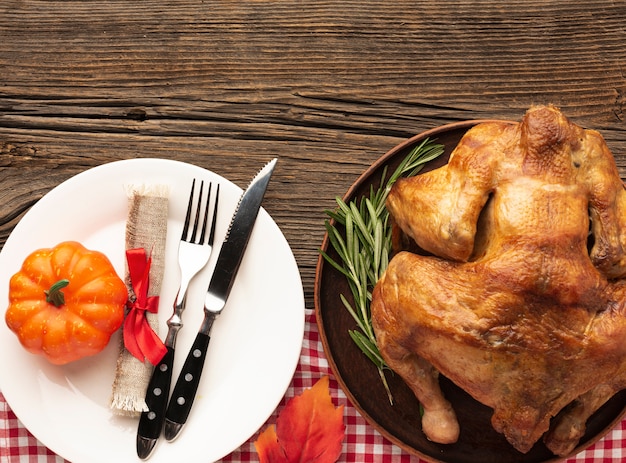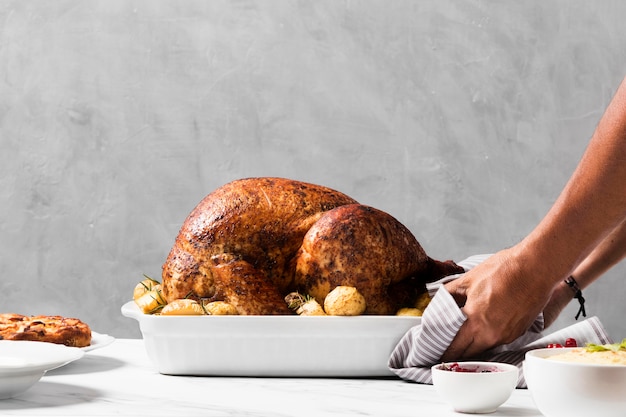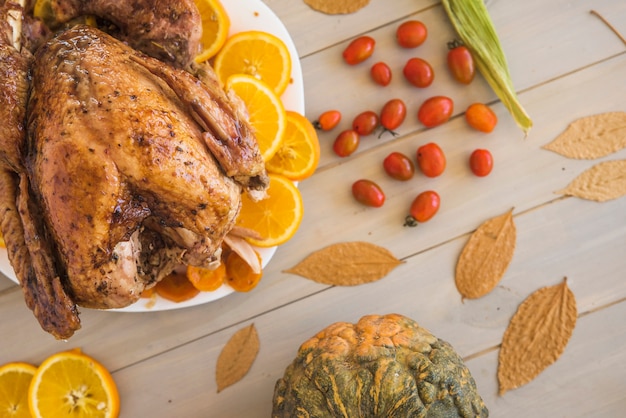Alright, everyone, let's get down to brass tacks. We're tackling the mighty 20lb turkey. Now, I know what you're thinking – "That's a beast of a bird!" And you're absolutely right. It's not your everyday roast chicken, that's for sure. But don't fret, because with a little planning and a touch of culinary confidence, you can roast a turkey that'll be the star of your holiday table, no matter the occasion.
I've been in the kitchen for years, cooking up all sorts of feasts, and let me tell you, I've learned a thing or two about turkeys. From selecting the perfect bird to getting the timing just right, I've got you covered. So grab a comfy chair, brew yourself a cuppa, and let's get started on this delicious journey!
(Part 1) The Turkey: Choosing Your Bird

The first step, and arguably the most crucial, is choosing your turkey. Think of this as the foundation of your entire feast. You want a bird that's going to deliver juicy, flavorful meat, and for that, you need quality. I always recommend going for a free-range turkey whenever possible, raised with care and attention. These birds tend to have more flavor and a slightly firmer texture.
Tip: Check the Weight - It's All About Proportion
A 20lb turkey is a statement piece. It's going to feed a serious crowd, so make sure you've got enough hungry guests, oven space, and a carving board that can handle the grand prize. Remember, this isn't a solo operation!
Tip: Don’t Forget the Stuffing: A Delicious Dilemma
Stuffing is a classic turkey companion, but it's a bit of a two-sided coin. Stuffing your turkey adds a lovely depth of flavor, but it can also make the bird a bit trickier to cook evenly. If you're going the stuffing route, it's best to stuff the turkey right before roasting and ensure that it reaches an internal temperature of 165°F (74°C).
Tip: Brining: A Secret Weapon for Juicy Meat
Now, here's where things get exciting. Brining is a simple yet magical step that takes your turkey to the next level. It involves soaking the turkey in a salt solution, which helps retain moisture and keeps the meat incredibly succulent. Think of it as giving your turkey a spa treatment. I've found that brining adds a fantastic depth of flavor and helps the turkey cook more evenly.
You can find countless brining recipes online, but a basic solution of salt, sugar, and water does wonders. Just make sure the turkey is completely submerged and let it soak in the fridge for 12-24 hours before roasting. Trust me, it's worth the extra effort!
(Part 2) The Preparation: Getting Ready to Roast

Now that you've got your turkey ready to go, it's time to prep your oven and get the bird ready for its starring role. Let's get those oven mitts on!
Tip: Preheat the Oven: Setting the Stage
Preheat your oven to 325°F (160°C). This is the standard temperature for roasting turkeys, creating a nice, even heat. Don't rush the process; you want the oven hot and ready when the turkey arrives.
Tip: Stuffing the Bird (If You Dare)
If you've decided to stuff your turkey, remember to do it just before roasting. Stuffing can make the turkey a bit more challenging to cook evenly, so be sure to pack it in tightly and ensure that it reaches that 165°F (74°C) mark.
Tip: Seasoning the Turkey: A Symphony of Flavors
Here's where you can really have some fun! I like to keep my turkey seasoning simple, but full of flavor. A blend of salt, pepper, and aromatic herbs like rosemary and thyme is all you need. Don't be shy – rub the seasoning generously all over the turkey, inside and out.
Tip: Place the Turkey in the roasting pan: Finding the Right Home
Select a roasting pan large enough to comfortably accommodate the turkey without any overcrowding. I usually add some vegetables like carrots, onions, and celery to the bottom of the pan. This adds a lovely depth of flavor and helps create a delicious sauce for later.
Tip: Add Butter or Oil: A Touch of Luxury
To keep the turkey moist and flavorful, I always add a generous knob of butter or a drizzle of oil to the top of the bird. You can also use a basting solution for extra flavor.
Tip: Cover the Turkey: Keeping It Moist
To start, I cover the turkey with foil for the first part of the roasting process. This traps in the moisture and prevents the bird from drying out.
(Part 3) The Cooking Time: How Long to Roast a 20 lb Turkey

Now, here's where things get a bit more technical. The cooking time for a 20lb turkey will vary depending on your oven and the individual bird. As a general rule, you can expect to roast a 20lb turkey for about 4-5 hours, but it's crucial to use a meat thermometer to ensure it's cooked through.
The Turkey’s Internal Temperature: The Key to Perfection
The most reliable way to tell if your turkey is cooked is by using a meat thermometer. The internal temperature should reach 165°F (74°C) in the thickest part of the thigh, without touching any bone. You can also check the temperature in the breast, which should reach 160°F (71°C).
The Cooking Time: A Rough Guide to Help You Plan
Here's a rough guide for cooking times for a 20lb turkey, but always remember to check the internal temperature:
| turkey weight | Cooking Time |
|---|---|
| 12-14 pounds | 3-4 hours |
| 16-18 pounds | 4-5 hours |
| 20-24 pounds | 5-6 hours |
(Part 4) The Resting Time: Letting the Turkey Relax
Once your turkey has reached the desired internal temperature, it's time to let it relax. This is a crucial step that allows the juices to redistribute throughout the meat, resulting in a more flavorful and tender turkey.
Tip: Resting Time: A Moment of Patience
I recommend resting the turkey for at least 30 minutes before carving. You can cover it with foil to keep it warm while it rests.
(Part 5) Carving the Turkey: A Grand Finale
After the turkey has had its well-deserved rest, it's time for the grand finale – carving! This is where things can get a bit messy, so make sure you have a carving board and a sharp knife at the ready.
Tip: Use a Sharp Knife: A Key to Clean Cuts
A sharp knife will make carving much easier and prevent you from tearing the meat.
Tip: Start with the Breast: A Gentle Approach
I usually start by carving the breast. You can remove the breastbone to make it easier to slice the meat.
Tip: Carve the Legs and Thighs: Unlocking Flavor
Next, carve the legs and thighs. You can use a fork to hold the meat while you slice.
Tip: Serve the Turkey: A Feast for the Senses
Once you've carved the turkey, arrange the slices on a serving platter and serve with all the trimmings. Don't forget to have plenty of gravy on hand!
(Part 6) The Gravy: A Classic Pairing
No turkey dinner is complete without a rich and flavorful gravy. I love making gravy from the pan drippings, as it adds a deep, savory flavor to the sauce.
Tip: Make Gravy from Pan Drippings: Harnessing Flavor
To make gravy, simply pour the pan drippings into a saucepan, bring to a simmer, and whisk in a slurry of flour and water. Cook until the gravy has thickened, and then season to taste.
Tip: Add Flavor: Elevating the Gravy
To add extra flavor to the gravy, you can also stir in some of the roasted vegetables from the pan.
(Part 7) Leftovers: Turning Leftovers into Treasure
You're bound to have some leftover turkey, and that's a good thing! Leftovers are the perfect opportunity to create delicious new dishes.
Tip: Leftover turkey recipes: A World of Possibilities
There are countless possibilities for leftover turkey. Here are some of my favorites:
- turkey sandwiches: A classic!
- turkey soup: A hearty and comforting meal.
- turkey salad: A light and refreshing option.
- turkey pot pie: A savory and satisfying dish.
- Turkey enchiladas: A twist on a Mexican classic.
- Turkey stir-fry: A quick and easy meal.
- Turkey pizza: A fun and flavorful way to use up leftovers.
(Part 8) Troubleshooting: Common Turkey Problems and Their Solutions
Okay, we've covered the basics, but what about those common turkey cooking problems? Don't worry, I've been there too!
Tip: Dry Turkey: Preventing Dryness
One of the most common problems is a dry turkey. This can happen if the turkey is overcooked or not basted enough. To prevent this, make sure to baste the turkey regularly during cooking, and use a meat thermometer to ensure it doesn't overcook.
Tip: Undercooked Turkey: Ensuring Safety
Another common problem is an undercooked turkey. This can happen if the turkey is not cooked to the correct internal temperature. Always use a meat thermometer and cook the turkey until it reaches 165°F (74°C) in the thickest part of the thigh.
Tip: Unevenly Cooked Turkey: Maintaining Consistent Heat
If the turkey is unevenly cooked, it could be because the oven temperature is not consistent. Make sure your oven is preheated properly and maintain a consistent temperature throughout the cooking process.
Tip: Burnt Turkey: Preventing Burning
If the turkey is burnt, it could be because the oven temperature is too high or the turkey is too close to the heating element. Lower the oven temperature if necessary, and make sure the turkey is not touching the top or sides of the oven.
FAQs: Common Turkey Questions
Let's answer some common turkey questions, shall we?
1. Can I roast a turkey in a slow cooker?
Yes, you can roast a turkey in a slow cooker, especially a smaller bird. Just make sure the turkey is small enough to fit in the slow cooker and cook it on low for 6-8 hours.
2. Can I freeze a turkey?
Yes, you can freeze a turkey for up to a year. Make sure you wrap the turkey tightly in plastic wrap or aluminum foil before freezing.
3. How do I defrost a frozen turkey?
The best way to defrost a frozen turkey is in the refrigerator. Allow 24 hours for every 5 pounds of turkey to defrost.
4. What if my turkey is too big for my oven?
If your turkey is too big for your oven, you can cook it in sections. Just make sure each section is cooked to the correct internal temperature.
5. What are some tips for cooking a turkey for a crowd?
Here are some tips for cooking a turkey for a crowd:
- Choose a large enough roasting pan.
- Consider cooking the turkey in sections if it’s too big.
- Make sure you have enough serving plates and utensils.
- Have a plan for carving the turkey and serving it.
- Prepare side dishes ahead of time to reduce stress on the day of the feast.
And there you have it, folks! A comprehensive guide to roasting a 20lb turkey, with all the tips and tricks you need to pull off a truly impressive feast. Now, go forth and conquer those holiday meals, with confidence and a smile. Happy cooking!
Everyone is watching

Prime Rib Roast Cooking Time Chart: Per Pound Guide
Cooking TipsPrime rib roast. Just the name conjures images of lavish dinners, crackling fires, and hearty laughter. It’s ...

How Long to Bake Potatoes in the Oven (Perfect Every Time)
Cooking TipsBaked potatoes are a staple in my kitchen. They're incredibly versatile, delicious, and surprisingly easy to m...

Perfect Rice Every Time: The Ultimate Guide to Cooking Rice
Cooking TipsAs a self-proclaimed foodie, I've always been a bit obsessed with rice. It's the foundation of countless cuisi...

The Ultimate Guide to Cooking Asparagus: Tips, Techniques, and Recipes
Cooking TipsAsparagus. The mere mention of this spring delicacy conjures up images of vibrant green spears, crisp and burs...

Ultimate Guide to Cooking the Perfect Thanksgiving Turkey
Cooking TipsThanksgiving. Just the word conjures up images of overflowing tables laden with delicious food, the scent of r...
